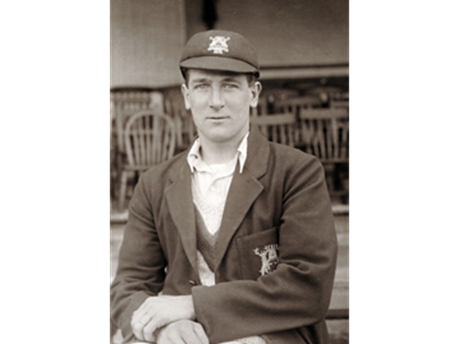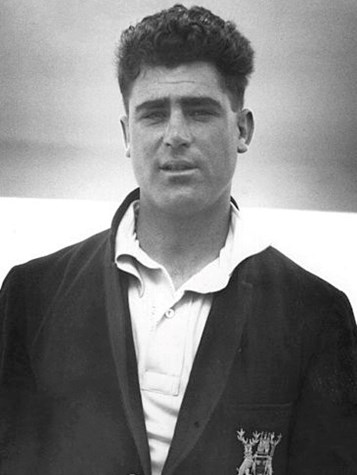Larwood and Voce
Cricket is an integral part of Nottinghamshire sporting life. There have been numerous cricketing legends coming out of the county team, including Harold Larwood and Bill Voce, known as two of the best fast bowlers in the country. Their influence is still felt in the game today and they are remembered at the Nottinghamshire team’s home ground - one of the most important sporting venues in the country, Trent Bridge.
Early life
Harold Larwood MBE was born on 14 November 1904, in Nuncargate, near Kirkby in Ashfield, in Nottingham. He was the child of miner Robert Larwood and Mary Sharman, and the fourth of five sons. Harold left Kirkby Woodhouse School at 13, and also went into mining working with the pit ponies at Annesley Colliery. He showed talent in playing cricket for his local team Nuncargate, and by 1920 was in the first team.
Harold was encouraged to attend a trial at Trent Bridge to play for the county and joined the Second XI team in 1923. He made his first team debut in 1924 against Northamptonshire at Trent Bridge at 19, and throughout the next year he was a first team regular. Harold was selected to represent England against Australia in 1926 at Lord’s Cricket Ground, where the England team regained the Ashes at another famous London sports venue, The Oval.
William Voce, known as Bill, was born several years after Harold at Annesley Woodhouse, near Kirkby in Ashfield, on 8 August 1909, and lived in Hucknall in the late 1920s. He played for the Annesley Colliery team at a young age, and went to Trent Bridge for a trial in 1926 when his exceptional playing abilities got him noticed. He gained a place in the Nottinghamshire XI in 1927, and took part in 19 matches for the country obtaining 36 wickets. He made his first-class debut for the county against Gloucestershire in 1927.

The fearsome bowler
Harold meanwhile earned a reputation for being a fearsome bowler, with tremendous speed and accuracy. He further enhanced his career in cricket tests against Australia, in the West Indies, South Africa, and New Zealand, in the late 1920s and early 1930s. It was the 1932-33 tour to Australia where Harold made his most important stamp on the history of test cricket. England captain, Douglas Jardine, ordered Harold and his fellow Nottinghamshire team mate Bill Voce to use bodyline, or fast-leg theory, against their opponents. This meant bowling and aiming their deliveries directly at the Australian batsmen in an effort to unsettle and intimidate their challengers.
The tactic certainly worked and England took the series 4-1, with Harold taking 33 wickets at an average of just 19 runs apiece. Although the tactic was a huge success, the bodyline strategy was widely denounced as not being within the spirit of the game. Harold, who refused to apologise for his actions, never played for England again. He also splintered a bone in his foot during the final test. He continued to play for Nottinghamshire until 1938, when he retired with a 14-year career total of 1,427 first-class wickets at an average 17.51, including 78 wickets with an average of 28.53 in 21 tests. Harold was also a useful middle-order batsman, with 7,290 first-class runs and a respectable three centuries to his name.
Bill Voce’s success
Bill was selected for a tour of the West Indies and made his test debut in 1930. At the beginning of his career, he bowled medium pace and while his team mates advised him to stick to spin bowling many also urged him to bowl fast. In 1931, Bill was only second to his team mate Harold with 101 wickets for just under 17 runs apiece. He was chosen as one of the Wisden Cricketers of the Year 1933, and was named for the English tour of Australia in the 1932-33 test. He followed the same order by England captain, Douglas Jardine, to use bodyline, or fast-leg theory, against their opponents.
Retirement and post-war cricket
After retiring from the game, Harold lived in Blackpool with his wife and five daughters and bought a sweet shop. Ironically he immigrated to Australia in 1950, the scene of his most controversial triumph. He went on to be honoured by his home country and received an MBE in 1993. Harold died on 22 July 1995, in Sydney, Australia. In 2009, he was inducted into the ICC Hall of Fame.
Bill received a mid-season injury in 1937 and joined the armed forces during the Second World War. He continued to play cricket post-war and in 1946, after a particularly good performance in a test trial, Bill was picked for a third tour of Australia for the 1946-47 Ashes series. He failed however to take a test wicket on the tour and played his final test match in Melbourne in 1947. He continued to play for Nottinghamshire until 1952. In his lifetime, Bill played 27 tests and scored 308 runs at an average of 13.39 and took 98 wickets at an average of 27.88. Bill died on 6 June 1984 at Lenton, in Nottingham. Harold and Bill's cricketing legacy lives on as two of Ashfield's finest bowlers who forged a truly outstanding partnership.
Places to visit
Harold and Bill were both born within minutes of one another in Nottingham, in Nuncargate and Annesley Woodhouse respectively. Visit nearby Annesley Old Church and Annesley Hall to get a flavour of the area they both grew up in. Head to Kirkby in Ashfield and Hucknall to discover places they lived or visited in their younger years. Take a trip to Trent Bridge Cricket Ground, in Nottingham, for a game where Harold and Bill both started their county careers.